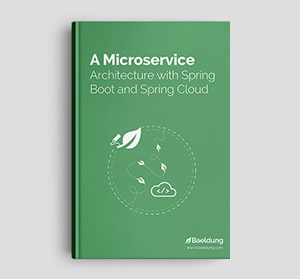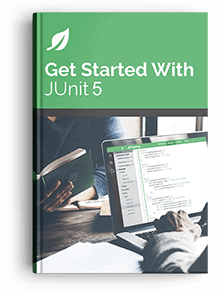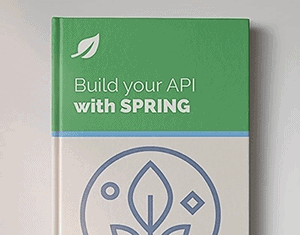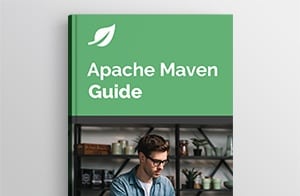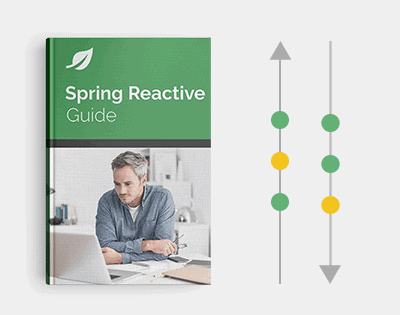Yes, we're now running our Black Friday Sale. All Access and Pro are 33% off until 2nd December, 2025:
Jackson JSON Views
Last updated: February 12, 2020
1. Overview
In this tutorial, we’ll go over how to use Jackson JSON Views to serialize/deserialize objects, customize the views and finally – how to start integrating with Spring.
2. Serialize Using JSON Views
First – let’s go through a simple example – serialize an object with @JsonView.
Here is our view:
public class Views {
public static class Public {
}
}And the “User” entity:
public class User {
public int id;
@JsonView(Views.Public.class)
public String name;
}Now let’s serialize a “User” instance using our view:
@Test
public void whenUseJsonViewToSerialize_thenCorrect()
throws JsonProcessingException {
User user = new User(1, "John");
ObjectMapper mapper = new ObjectMapper();
mapper.disable(MapperFeature.DEFAULT_VIEW_INCLUSION);
String result = mapper
.writerWithView(Views.Public.class)
.writeValueAsString(user);
assertThat(result, containsString("John"));
assertThat(result, not(containsString("1")));
}Note how, because we’re serializing with a specific view active, we’re seeing only the right fields being serialized.
It’s also important to understand, that – by default – all properties not explicitly marked as being part of a view, are serialized. We are disabling that behavior with the handy DEFAULT_VIEW_INCLUSION feature.
3. Use Multiple JSON Views
Next – let’s see how to use multiple JSON Views – each has different fields as in the following example:
Here we have to views where Internal extends Public, with the internal view extending the public one:
public class Views {
public static class Public {
}
public static class Internal extends Public {
}
}And here is our entity “Item” where only the fields id and name are included in the Public view:
public class Item {
@JsonView(Views.Public.class)
public int id;
@JsonView(Views.Public.class)
public String itemName;
@JsonView(Views.Internal.class)
public String ownerName;
}If we use the Public view to serialize – only id and name will be serialized to JSON:
@Test
public void whenUsePublicView_thenOnlyPublicSerialized()
throws JsonProcessingException {
Item item = new Item(2, "book", "John");
ObjectMapper mapper = new ObjectMapper();
String result = mapper
.writerWithView(Views.Public.class)
.writeValueAsString(item);
assertThat(result, containsString("book"));
assertThat(result, containsString("2"));
assertThat(result, not(containsString("John")));
}But if we use the Internal view to perform the serialization, all fields will be part of the JSON output:
@Test
public void whenUseInternalView_thenAllSerialized()
throws JsonProcessingException {
Item item = new Item(2, "book", "John");
ObjectMapper mapper = new ObjectMapper();
String result = mapper
.writerWithView(Views.Internal.class)
.writeValueAsString(item);
assertThat(result, containsString("book"));
assertThat(result, containsString("2"));
assertThat(result, containsString("John"));
}4. Deserialize Using JSON Views
Now – let’s see how to use JSON Views to deserialize objects – specifically, a User instance:
@Test
public void whenUseJsonViewToDeserialize_thenCorrect()
throws IOException {
String json = "{"id":1,"name":"John"}";
ObjectMapper mapper = new ObjectMapper();
User user = mapper
.readerWithView(Views.Public.class)
.forType(User.class)
.readValue(json);
assertEquals(1, user.getId());
assertEquals("John", user.getName());
}Note how we’re using the readerWithView() API to create an ObjectReader using the given view.
5. Customize JSON Views
Next – let’s see how to customize JSON Views. In the next example – we want to make the User “name” UpperCase in the serialization result.
We will use BeanPropertyWriter and BeanSerializerModifier to customize our JSON view. First – here is the BeanPropertyWriter UpperCasingWriter to transform the User name to upper case:
public class UpperCasingWriter extends BeanPropertyWriter {
BeanPropertyWriter _writer;
public UpperCasingWriter(BeanPropertyWriter w) {
super(w);
_writer = w;
}
@Override
public void serializeAsField(Object bean, JsonGenerator gen,
SerializerProvider prov) throws Exception {
String value = ((User) bean).name;
value = (value == null) ? "" : value.toUpperCase();
gen.writeStringField("name", value);
}
}And here is the BeanSerializerModifier to set the User name BeanPropertyWriter with our custom UpperCasingWriter:
public class MyBeanSerializerModifier extends BeanSerializerModifier{
@Override
public List<BeanPropertyWriter> changeProperties(
SerializationConfig config, BeanDescription beanDesc,
List<BeanPropertyWriter> beanProperties) {
for (int i = 0; i < beanProperties.size(); i++) {
BeanPropertyWriter writer = beanProperties.get(i);
if (writer.getName() == "name") {
beanProperties.set(i, new UpperCasingWriter(writer));
}
}
return beanProperties;
}
}Now – let’s serialize a User instance using the modified Serializer:
@Test
public void whenUseCustomJsonViewToSerialize_thenCorrect()
throws JsonProcessingException {
User user = new User(1, "John");
SerializerFactory serializerFactory = BeanSerializerFactory.instance
.withSerializerModifier(new MyBeanSerializerModifier());
ObjectMapper mapper = new ObjectMapper();
mapper.setSerializerFactory(serializerFactory);
String result = mapper
.writerWithView(Views.Public.class)
.writeValueAsString(user);
assertThat(result, containsString("JOHN"));
assertThat(result, containsString("1"));
}6. Using JSON Views With Spring
Finally – let’s take a quick look at using JSON views with the Spring Framework. We can leverage the @JsonView annotation to customize our JSON response at the API level.
In the following example – we used the Public view to respond:
@JsonView(Views.Public.class)
@RequestMapping("/items/{id}")
public Item getItemPublic(@PathVariable int id) {
return ItemManager.getById(id);
}The response is:
{"id":2,"itemName":"book"}And when we used the Internal view as follows:
@JsonView(Views.Internal.class)
@RequestMapping("/items/internal/{id}")
public Item getItemInternal(@PathVariable int id) {
return ItemManager.getById(id);
}That was the response:
{"id":2,"itemName":"book","ownerName":"John"}If you want to dive deeper into using the views with Spring 4.1, you should check out the Jackson improvements in Spring 4.1.
7. Conclusion
In this quick tutorial, we had a look at the Jackson JSON views and the @JsonView annotation. We showed how to use JSON Views to have fine-grained control over our serialize/deserialize process – using a single or multiple views.
The code backing this article is available on GitHub. Once you're logged in as a Baeldung Pro Member, start learning and coding on the project.






